About Humming-Birds
By T. M. (Thomas Mayo) Brewer
Annotations by Rene Marzuk
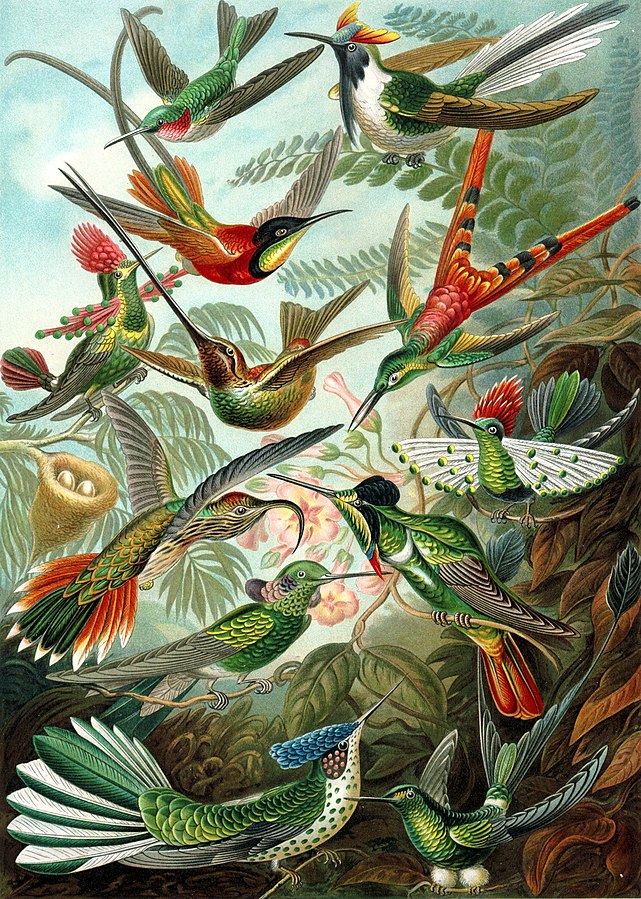
All the readers of Our Young Folks must remember Mrs. Stowe’s charming sketch of Hum the Son of Buz, which appeared in its first number.[1] It was an interesting account of the peculiar habits of a young Ruby-throated Humming-Bird, for several weeks her petted companion. Some novel facts in regard to the food and manner of life of these tiny specimens of bird-kind were there presented with a freshness that gave them great interest. We shall endeavor to give a general account of this wonderfully beautiful family of birds, although we cannot hope to invest it with an equal charm.
No birds are so universally attractive as the Humming-Birds. They are the smallest in size, the most brilliantly beautiful in plumage, and have the most numerous varieties of any of the feathered families.[2] They are found nowhere except in the New World, but here they may be met with anywhere, from the Falkland Islands of South America almost to Greenland in North America. They are most abundant in the warmer portions of the continent, especially in the West India Islands and in Central America and the northern states of South America.
More than three hundred different kinds of Humming-Birds have been already described, and our best-informed naturalists believe that not less than four hundred exist. So far as men of science have studied their habits, it has been found that all these different varieties have very nearly the same peculiarities, modified chiefly by the differences in their places of residence. Some Humming-Birds, like our common Ruby-throat, are found scattered over a very large extent of country. This variety occurs in all the United States, and as far north as the Arctic regions; other kinds are found only in small lonely islands. Some Humming-Birds remain all the year in the same localities; others only visit certain parts of America during the warm season.[3]
The food of Humming-Birds is now known to consist almost entirely of insects. They were once supposed to subsist chiefly on the sweets they obtained from honey-bearing flowers, and in confinement they have been made to live partly upon sweetened water; but the honey of plants is not alone their natural food, and is insufficient for them.
In order to obtain its insect-food the Humming-Bird is provided with a tongue of very peculiar structure, the anterior portions of which are made up of two long and hollow thread-like tubes. These unite behind and are closed at the end, as represented, magnified, in the figures below. This forked and hollow tongue the bird thrusts in and out of the tube-shaped flowers with the rapidity of a flash, and captures the minute insects lodged in their depths.[4]
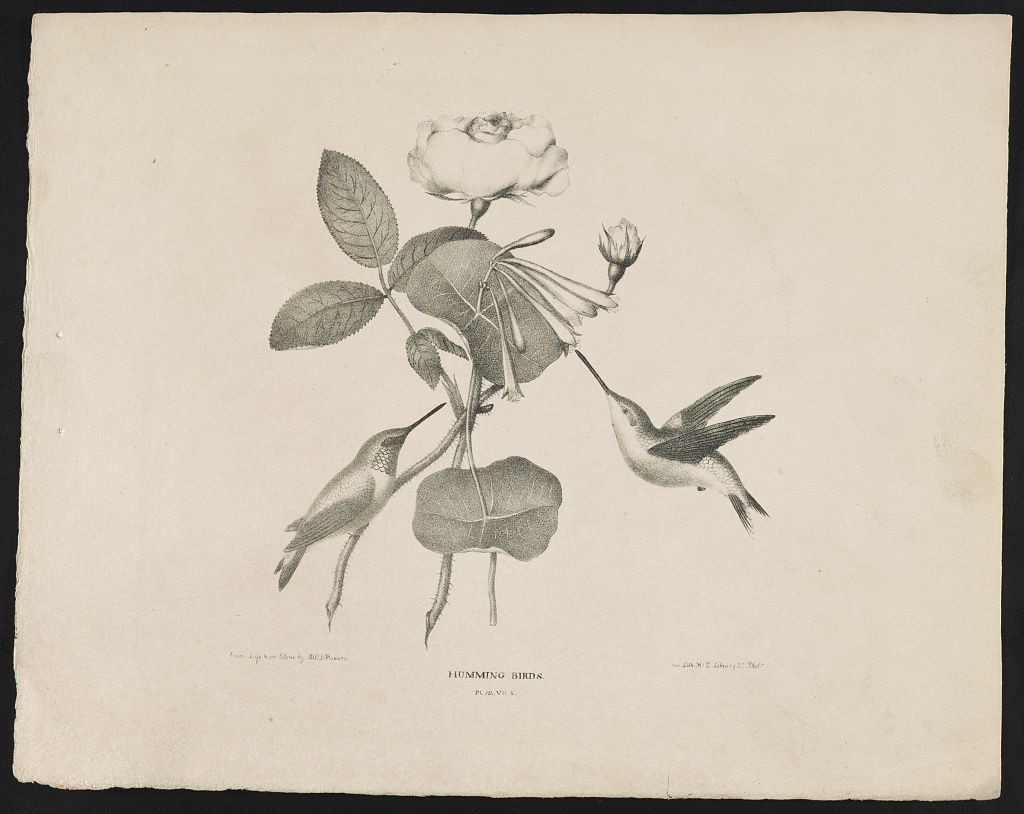
These tiny birds are adorned with more brilliant plumage than any other family of the whole feathered tribe. It is impossible to give our young readers any adequate description of the beauty and variety of the bright colors of nearly all Humming- Birds. These colors excite wonder and admiration, even when prepared for exhibition in ornithological collections; but when living the brilliancy of their colors is far greater than when dead.
Travellers who have seen them flitting about like beams of variously tinted light in the dark green woods of their native forests tell us they know nothing in nature that can be compared with them. Even the colors of the topaz, the emerald, the ruby, and the amethyst, to which the bright tints of the Humming-Birds have been likened, pale in the comparison. The various hues of all these gems are often seen combined in the plumage of the same bird, now one appearing and now another, with the changes of light and shade.
Without attempting to give a learned account of the different classes into which naturalists now divide Humming-Birds, we will mention only a few of the more marked differences which distinguish them. Some have perfectly straight bills; others have bills very much curved. These are nearly all tropical varieties, living the year round in the same climate. A few varieties have bills which curve upwards in a very singular manner,—an admirable adaptation for reaching up into flowers growing in the forms of pendent tubes or bells. Formerly all Humming-Birds were divided into two classes,—those with straight bills and those with curved bills. But later writers have subdivided the straight-billed into two classes and the curved-billed into three. The first two are those with short rounded tail-feathers, and those with very long and forked tails. These are all or nearly all birds of temperate climates, migrating from them in the colder season. The three varieties of the curved-billed birds are those with long centre tail-feathers, those with curious sabre-like wing-feathers and rounded tails, and those with very short tails and very much rounded bills.
In the tropical regions of America Humming-Birds in great number and variety swarm throughout the forests. In other portions of the same country, where the forests have been cut down and the land tilled, the Humming-Birds equally abound, and seem to delight in the society of man. As we recede from the warm regions their numbers decrease. Some are found in very high northern latitudes, others in equally far southern regions, while others seem to prefer high mountains, where the temperature is quite low. We have the nest of a South American Humming-Bird, which the late Captain Couthouy found on the eastern slope of Mount Pichincha, at a height of ten thousand five hundred feet.[5] Another traveller met with Humming- Birds flying about in a snow-storm near the Straits of Magellan.[6]
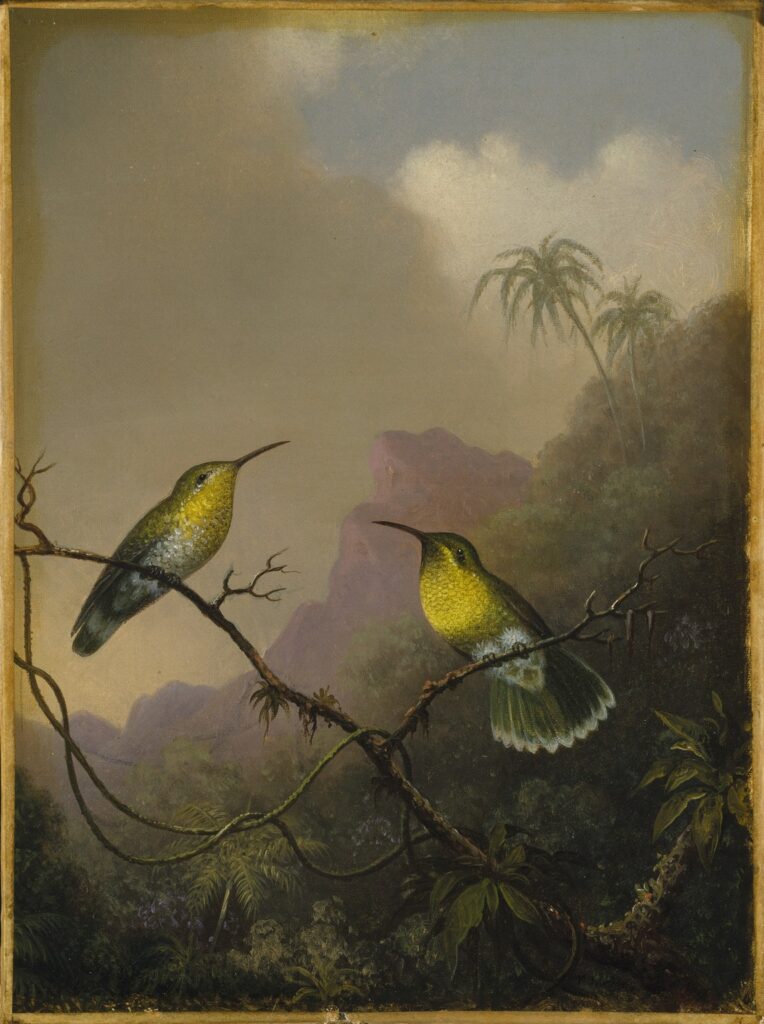
The habits of all Humming-Birds are so very nearly alike that a description of the peculiarities of one will serve for them all. They are almost always on the wing, moving with great rapidity and ease. They flit about in short, quick flights. Like flashes of light they dart now this way and now that. Their wings are so constructed as to give them the power of hovering over a flower and keeping themselves in this position a long time; some writers say, for hours.[7]
Their boldness and intrepidity is surprising in birds so small. They do not hesitate to attack birds greatly their superiors in strength that approach too near their nests, or even to fly in the face of any intruder when they have young. This boldness and anxiety is often fatal, betraying their nests to the naturalist seeking them for his collection.
The nests of Humming-Birds are built with exquisite delicacy, of soft materials, and are warm, compact, and strong. They are placed on the horizontal branches of trees, a few feet from the ground, and are usually made of silky vegetable down. Over this they fasten, with their saliva, a strong covering of gray moss. This appears to be an instinctive endeavor to conceal their nest by making it resemble the moss-covered limb on which it is built. It is a curious fact that often this mossy covering is not put on until after the female has occupied the nest, her mate busying himself with completing the moss-work while she is sitting upon her eggs.
But the nests of Humming-Birds are not alike. Some vary in their materials, others in their shape. One kind builds a hanging nest under a large leaf. It is curiously wrought of spiders’ webs, and has its opening underneath. The smallest known bird of this family is found in the island of Jamaica.[8] It is only two inches long, and its outstretched wings are only three inches across. Its nest is not larger than a thimble, and is woven of spiders’ threads and silk and covered on the outside with fine moss. The eggs are very small, looking like little white homœopathic pills. The Humming- Bird’s eggs are always white, and only two in number.[9]
Many attempts have been made to domesticate Humming-Birds, but these have been only partially successful. The birds have soon died, probably from change of diet, or from inability to endure the extremes of cold and heat. If a substitute for their natural food could be found, they would probably live and thrive in confinement, and become very tame and familiar.[10]
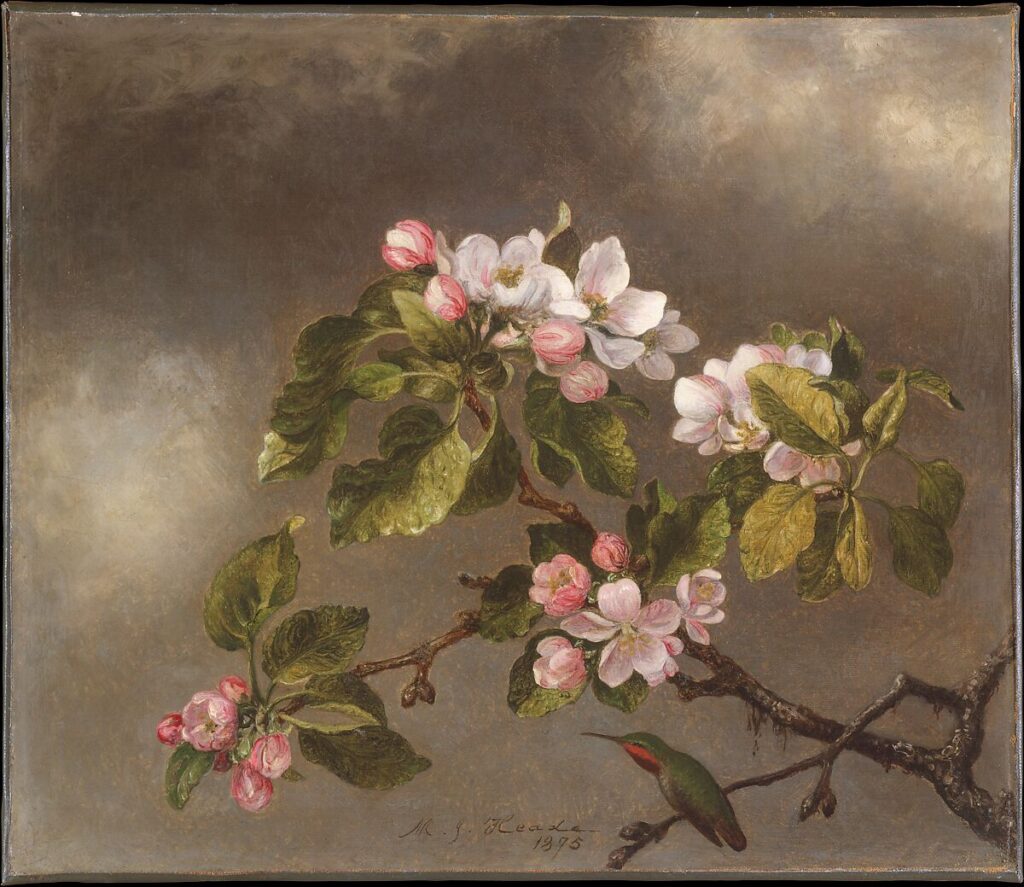
Several instances are known of their being kept in this manner, and in every case they have been, like Mrs. Stowe’s pet, very docile and affectionate. A young Englishman, as he was about to sail from Jamaica, caught a Mango Humming-Bird on her nest, and, cutting off the twig on which the latter was built, brought nest, eggs, and parent on board. The bird was fed with honey and water, became tame, and hatched out two young birds during the passage. The mother died, but the young birds were brought to England, and were for some weeks in the possession of Lady Hammond, readily taking honey from her lips. One of them lived two months after its arrival.
Within the limits of the United States seven different kinds of Humming-Birds are found, though two of them are very rare and may not belong here.[11] These are the Black-throated or Mango Humming-Bird, one of the curved-billed or tropical forms.[12] This is a common West-Indian variety, and is only found in our most southern State, Florida, and rarely there. Its plumage is resplendent with a metallic lustre of green and gold.
The common Ruby-throat is familiar to us all.[13]
The Black-chinned Humming-Bird of California is similar to our common variety.[14]
The Red-backed Humming-Bird is the most common kind in the States on the Pacific, and is found from the Gulf of California to Nootka Sound.[15] It is very prettily marked, but is not a brilliant bird, having very little lustre in its plumage.
The Broad-tailed Humming-Bird is only found in Texas, and is also very much like the common Ruby-throat.[16]
Our most beautiful variety, the Anna Humming-Bird,—so called in honor of Anna, Duchess of Rivoli, a lady greatly distinguished for her love of natural history, —is very abundant in California.[17] Its entire head, neck, and throat are covered with feathers of a bright metallic amethystine red color. One other variety, with no common name, about which little is known, has been found on the southern borders of California. It most resembles the Anna Humming-Bird.
BREWER, T. M. [THOMAS MAYO]. “ABOUT HUMMING-BIRDS.” OUR YOUNG FOLKS. AN ILLUSTRATED MAGAZINE’S VOL. V, NO. IX(SEPTEMBER 1869): 578-82.
[1] The author references Harriet Beecher Stowe’s sketch “Hum, the Son of Buz,” also included in our anthology.
[2] There are almost 340 species of hummingbirds in the world, all of them occurring in the American continent.
[3] Hummingbirds migrate yearly, with some species covering thousands of mile.
[4] Hummingbird’s tongues can stick out as far as the bill is long!
[5] In part IV of the series of essays “Bird Architecture,” published in Scribner’s Monthly on December, 1878, pp. 161-76, Thomas Brewer refers to a hummingbird nest he received from the late Captain Joseph Couthouy, “taken by him, with its owner, near the snow-line on Mount Pichincha, at a height of 10,500 feet” (p. 168). Brewer identifies the bird as an Eriocnemis luciani. Mount Pichincha is located in Ecuador.
[6] The Strait of Magellan (Estrecho de Magallanes) is a channel that links the Atlantic and Pacific Ocean in South America. It is 350 miles long and 2-20 miles wide.
[7] Watch hummingbirds in flight in this video from Terra Mater.
[8] The smallest hummingbird, which is also the smallest bird in the world, it is actually found in Cuba, not Jamaica. It is known as Bee Hummingbird.
[9] Although two is the typical size of hummingbird clutches, sometimes they will also lay either one or three eggs. Hummingbirds’ nests, the smallest bird nests in the world, are woven with spiderweb thread and camouflaged with other materials.
[10] Trapping or keeping hummingbirds in captivity is illegal in the United States. They are a protected species under the Migratory Bird Treaty Act.
[11] According to the American Bird Conservancy‘s website, there are fifteen types of hummingbirds in the United States, without counting nine vagrant species.
[12] Black-throated Mango Hummingbirds are usually found in open habitats like forest edges, woodlands, and shrubby growth.
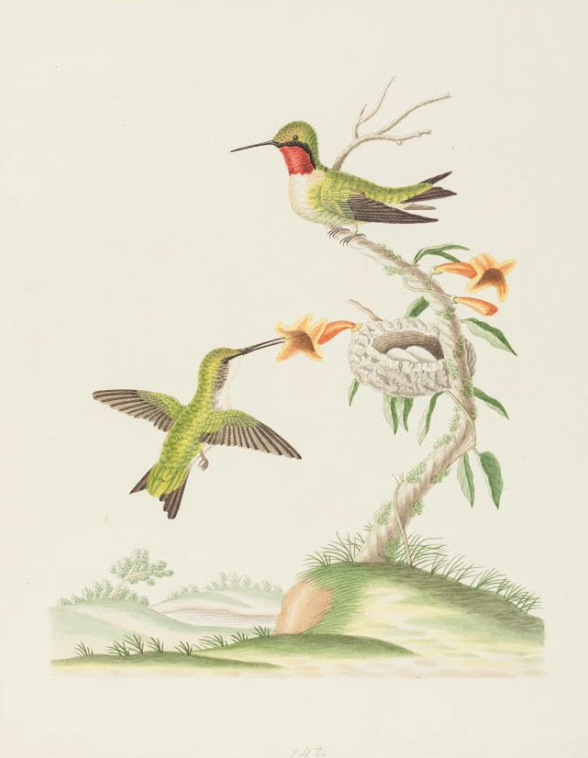
[13] Ruby-throated Hummingbird.
[14] Black-chinned Hummingbird.
[15] The author is probably referring to the Rufous Hummingbird.
[16] Broad-tailed Humming-Bird.
[17] Anna’s Hummingbird.
Contexts
Thomas Mayo Brewer (1814-1880) was an American naturalist. Trained as a doctor, he gave up medicine and dedicated himself to the sudy of birds and their eggs. In the nineteenth century, Europe became fascinated with hummingbirds and “hundreds of thousands were hunted and killed for their skin.” In fact, the commercial trade in bird feathers in the late nineteenth and early twentieth centuries sparked the fierce conservation movement that led to the creation of the National Audubon Societies. Many activists were women who opposed the killing of birds for the sake of the latest fashions.
Definitions from Oxford English Dictionary:
amethystine: Of a colour: resembling amethyst. Of an object: amethyst-coloured; violet-purple.
homœopathic: Very small or minute, like the doses usually given in homoeopathy. (Often humorous.)
ornithological: Of or relating to birds; avian.
pendent: Hanging; suspended from or as from the point of attachment, with the point or end hanging downwards; dependent. Of a tree: having branches that hang or droop down.
topaz: The name given (with or without distinguishing adjunct) to several highly valued precious stones. Also, the dark yellow colour of topaz.
Resources for Further Study
- “Not All Sweetness and Light: The Real Diet of Hummingbirds.”
- “Meet the World Smallest Bird: Cuba’s Bee Hummingbird.”
- Interactive experience designed to accompany a 2020 exhibition about Martin Johnson Heade’s hummingbird paintings. Courtesy of the Crystal Bridges Museum of American Art (Bentonville, AR).
Contemporary Connections
Learn how to keep your backyard hummingbird-friendly!